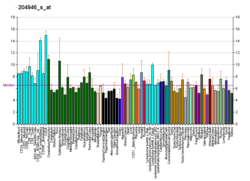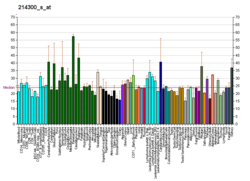TOP3A
DNA topoisomerase 3-alpha is an enzyme that in humans is encoded by the TOP3A gene.[5][6]
Function
This gene encodes a DNA topoisomerase, an enzyme that controls and alters the topologic states of DNA during transcription. This enzyme catalyzes the transient breaking and rejoining of a single strand of DNA which allows the strands to pass through one another, thus reducing the number of supercoils and altering the topology of DNA. This enzyme forms a complex with BLM which functions in the regulation of recombination in somatic cells.[6]
Meiosis

Recombination during meiosis is often initiated by a DNA double-strand break (DSB). During recombination, sections of DNA at the 5' ends of the break are cut away in a process called resection. In the strand invasion step that follows, an overhanging 3' end of the broken DNA molecule then "invades" the DNA of an homologous chromosome that is not broken forming a displacement loop (D-loop). After strand invasion, the further sequence of events may follow either of two main pathways leading to a crossover (CO) or a non-crossover (NCO) recombinant (see Genetic recombination and see Figure). The pathway leading to a NCO is referred to as Synthesis-dependent strand annealing (SDSA).
In the plant Arabidopsis thaliana, multiple mechanisms limit meiotic COs.[7] During meiosis TOP3A and RECQ4A/B helicase antagonize formation of COs in parallel to FANCM helicase.[7] Sequela-Arnaud et al.[7] suggested that CO numbers are restricted because of the long-term costs of CO recombination, that is, the breaking up of favorable genetic combinations of alleles built up by past natural selection.
In the budding yeast Saccharomyces cerevisiae, the topoisomerase III (TOP3)-RMI1 heterodimer (that catalyzes DNA single-strand passage) forms a conserved complex with Sgs1 helicase (an ortholog of the human Bloom syndrome helicase). This complex promotes early formation of NCO recombinants during meiosis[8] The TOP3-RMI1 strand passage activity appears to have two important functions during meiosis.[8] First, strand passage activity is employed early in coordination with Sgs1 helicase to promote proper recombination pathway choice. Second, strand passage activity is used later, independently of Sgs1 helicase, to prevent the persistence of unresolvable strand entanglements in recombination intermediates.
Interactions
TOP3A has been shown to interact with Bloom syndrome protein.[9][10][11][12]
References
- 1 2 3 ENSG00000177302 GRCh38: Ensembl release 89: ENSG00000284238, ENSG00000177302 - Ensembl, May 2017
- 1 2 3 GRCm38: Ensembl release 89: ENSMUSG00000002814 - Ensembl, May 2017
- ↑ "Human PubMed Reference:".
- ↑ "Mouse PubMed Reference:".
- ↑ Elsea SH, Fritz E, Schoener-Scott R, Meyn MS, Patel PI (Jan 1998). "Gene for topoisomerase III maps within the Smith-Magenis syndrome critical region: analysis of cell-cycle distribution and radiation sensitivity". American Journal of Medical Genetics. 75 (1): 104–8. doi:10.1002/(SICI)1096-8628(19980106)75:1<104::AID-AJMG21>3.0.CO;2-P. PMID 9450867.
- 1 2 "Entrez Gene: TOP3A topoisomerase (DNA) III alpha".
- 1 2 3 Séguéla-Arnaud M, Crismani W, Larchevêque C, Mazel J, Froger N, Choinard S, Lemhemdi A, Macaisne N, Van Leene J, Gevaert K, De Jaeger G, Chelysheva L, Mercier R (Apr 2015). "Multiple mechanisms limit meiotic crossovers: TOP3α and two BLM homologs antagonize crossovers in parallel to FANCM". Proceedings of the National Academy of Sciences of the United States of America. 112 (15): 4713–8. doi:10.1073/pnas.1423107112. PMC 4403193. PMID 25825745.
- 1 2 Kaur H, De Muyt A, Lichten M (Feb 2015). "Top3-Rmi1 DNA single-strand decatenase is integral to the formation and resolution of meiotic recombination intermediates". Molecular Cell. 57 (4): 583–94. doi:10.1016/j.molcel.2015.01.020. PMC 4338413. PMID 25699707.
- ↑ Wu L, Davies SL, North PS, Goulaouic H, Riou JF, Turley H, Gatter KC, Hickson ID (Mar 2000). "The Bloom's syndrome gene product interacts with topoisomerase III". The Journal of Biological Chemistry. 275 (13): 9636–44. doi:10.1074/jbc.275.13.9636. PMID 10734115.
- ↑ Freire R, d'Adda Di Fagagna F, Wu L, Pedrazzi G, Stagljar I, Hickson ID, Jackson SP (Aug 2001). "Cleavage of the Bloom's syndrome gene product during apoptosis by caspase-3 results in an impaired interaction with topoisomerase IIIalpha". Nucleic Acids Research. 29 (15): 3172–80. doi:10.1093/nar/29.15.3172. PMC 55826. PMID 11470874.
- ↑ Hu P, Beresten SF, van Brabant AJ, Ye TZ, Pandolfi PP, Johnson FB, Guarente L, Ellis NA (Jun 2001). "Evidence for BLM and Topoisomerase IIIalpha interaction in genomic stability". Human Molecular Genetics. 10 (12): 1287–98. doi:10.1093/hmg/10.12.1287. PMID 11406610.
- ↑ Brosh RM, Li JL, Kenny MK, Karow JK, Cooper MP, Kureekattil RP, Hickson ID, Bohr VA (Aug 2000). "Replication protein A physically interacts with the Bloom's syndrome protein and stimulates its helicase activity". The Journal of Biological Chemistry. 275 (31): 23500–8. doi:10.1074/jbc.M001557200. PMID 10825162.
Further reading
- Hanai R, Caron PR, Wang JC (Apr 1996). "Human TOP3: a single-copy gene encoding DNA topoisomerase III". Proceedings of the National Academy of Sciences of the United States of America. 93 (8): 3653–7. doi:10.1073/pnas.93.8.3653. PMC 39666. PMID 8622991.
- Fritz E, Elsea SH, Patel PI, Meyn MS (Apr 1997). "Overexpression of a truncated human topoisomerase III partially corrects multiple aspects of the ataxia-telangiectasia phenotype". Proceedings of the National Academy of Sciences of the United States of America. 94 (9): 4538–42. doi:10.1073/pnas.94.9.4538. PMC 20758. PMID 9114025.
- Kim JC, Yoon JB, Koo HS, Chung IK (Oct 1998). "Cloning and characterization of the 5'-flanking region for the human topoisomerase III gene". The Journal of Biological Chemistry. 273 (40): 26130–7. doi:10.1074/jbc.273.40.26130. PMID 9748294.
- Goulaouic H, Roulon T, Flamand O, Grondard L, Lavelle F, Riou JF (Jun 1999). "Purification and characterization of human DNA topoisomerase IIIalpha". Nucleic Acids Research. 27 (12): 2443–50. doi:10.1093/nar/27.12.2443. PMC 148446. PMID 10352172.
- Shimamoto A, Nishikawa K, Kitao S, Furuichi Y (Apr 2000). "Human RecQ5beta, a large isomer of RecQ5 DNA helicase, localizes in the nucleoplasm and interacts with topoisomerases 3alpha and 3beta". Nucleic Acids Research. 28 (7): 1647–55. doi:10.1093/nar/28.7.1647. PMC 102787. PMID 10710432.
- Wu L, Davies SL, North PS, Goulaouic H, Riou JF, Turley H, Gatter KC, Hickson ID (Mar 2000). "The Bloom's syndrome gene product interacts with topoisomerase III". The Journal of Biological Chemistry. 275 (13): 9636–44. doi:10.1074/jbc.275.13.9636. PMID 10734115.
- Lin CW, Darzynkiewicz Z, Li X, Traganos F, Bedner E, Tse-Dinh YC (Apr 2000). "Differential expression of human topoisomerase IIIalpha during the cell cycle progression in HL-60 leukemia cells and human peripheral blood lymphocytes". Experimental Cell Research. 256 (1): 225–36. doi:10.1006/excr.1999.4778. PMID 10739669.
- Brosh RM, Li JL, Kenny MK, Karow JK, Cooper MP, Kureekattil RP, Hickson ID, Bohr VA (Aug 2000). "Replication protein A physically interacts with the Bloom's syndrome protein and stimulates its helicase activity". The Journal of Biological Chemistry. 275 (31): 23500–8. doi:10.1074/jbc.M001557200. PMID 10825162.
- Lodge AJ, Anderson JJ, Ng SW, Fenwick F, Steward M, Haugk B, Horne CH, Angus B (Aug 2000). "Expression of topoisomerase IIIalpha in normal and neoplastic tissues determined by immunohistochemistry using a novel monoclonal antibody". British Journal of Cancer. 83 (4): 498–505. doi:10.1054/bjoc.2000.1293. PMC 2374664. PMID 10945498.
- Hu P, Beresten SF, van Brabant AJ, Ye TZ, Pandolfi PP, Johnson FB, Guarente L, Ellis NA (Jun 2001). "Evidence for BLM and Topoisomerase IIIalpha interaction in genomic stability". Human Molecular Genetics. 10 (12): 1287–98. doi:10.1093/hmg/10.12.1287. PMID 11406610.
- Freire R, d'Adda Di Fagagna F, Wu L, Pedrazzi G, Stagljar I, Hickson ID, Jackson SP (Aug 2001). "Cleavage of the Bloom's syndrome gene product during apoptosis by caspase-3 results in an impaired interaction with topoisomerase IIIalpha". Nucleic Acids Research. 29 (15): 3172–80. doi:10.1093/nar/29.15.3172. PMC 55826. PMID 11470874.
- Bi W, Yan J, Stankiewicz P, Park SS, Walz K, Boerkoel CF, Potocki L, Shaffer LG, Devriendt K, Nowaczyk MJ, Inoue K, Lupski JR (May 2002). "Genes in a refined Smith-Magenis syndrome critical deletion interval on chromosome 17p11.2 and the syntenic region of the mouse". Genome Research. 12 (5): 713–28. doi:10.1101/gr.73702. PMC 186594. PMID 11997338.
- Wang Y, Lyu YL, Wang JC (Sep 2002). "Dual localization of human DNA topoisomerase IIIalpha to mitochondria and nucleus". Proceedings of the National Academy of Sciences of the United States of America. 99 (19): 12114–9. doi:10.1073/pnas.192449499. PMC 129407. PMID 12209014.
- Wu L, Hickson ID (Nov 2002). "The Bloom's syndrome helicase stimulates the activity of human topoisomerase IIIalpha". Nucleic Acids Research. 30 (22): 4823–9. doi:10.1093/nar/gkf611. PMC 137159. PMID 12433984.
- Meetei AR, de Winter JP, Medhurst AL, Wallisch M, Waisfisz Q, van de Vrugt HJ, Oostra AB, Yan Z, Ling C, Bishop CE, Hoatlin ME, Joenje H, Wang W (Oct 2003). "A novel ubiquitin ligase is deficient in Fanconi anemia". Nature Genetics. 35 (2): 165–70. doi:10.1038/ng1241. PMID 12973351.
- Jiao R, Bachrati CZ, Pedrazzi G, Kuster P, Petkovic M, Li JL, Egli D, Hickson ID, Stagljar I (Jun 2004). "Physical and functional interaction between the Bloom's syndrome gene product and the largest subunit of chromatin assembly factor 1". Molecular and Cellular Biology. 24 (11): 4710–9. doi:10.1128/MCB.24.11.4710-4719.2004. PMC 416397. PMID 15143166.
- Yin J, Sobeck A, Xu C, Meetei AR, Hoatlin M, Li L, Wang W (Apr 2005). "BLAP75, an essential component of Bloom's syndrome protein complexes that maintain genome integrity". The EMBO Journal. 24 (7): 1465–76. doi:10.1038/sj.emboj.7600622. PMC 1142546. PMID 15775963.





